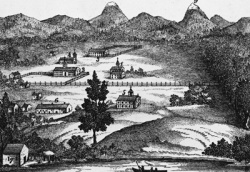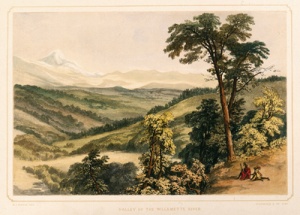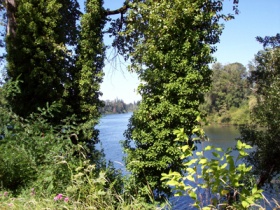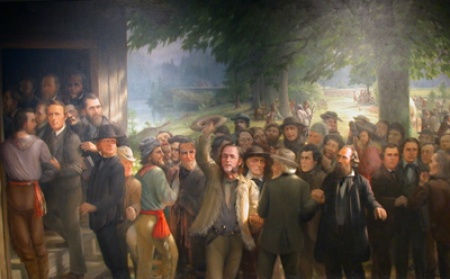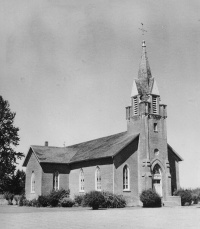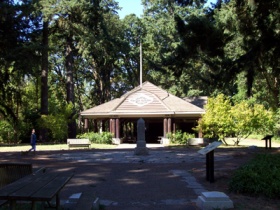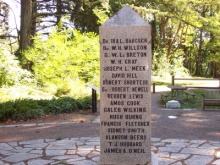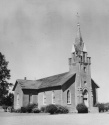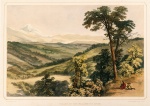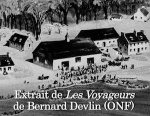French Prairie, Oregon
par Jetté, Melinda Marie
French Prairie, located in western Oregon’s Willamette Valley, takes its name from the bi-cultural French Canadian and Indian families who colonized the area in the 1820s and 1830s These French-Indian settlers served as important historical actors in Euro-American colonization of the region, which began with the overland fur trade in the 1810s. French Prairie was originally the home of the Ahantchuyuk Kalapuyans, an aboriginal people whose numbers declined precipitously during 1830s and 1840s as a result of disease and Euro-American emigration. The Willamette Valley later become the primary destination of the American Oregon Trail settlers of the 1840s. Following the eventual assimilation of the French-Indian families and the political ascendancy of the Anglo-Americans, the historical role of the francophones was often obscured in traditional texts on Oregon history. However, the history and heritage of the francophone settlers remained in the memories of their descendants. Today twenty-first century visitors to Champoeg State Heritage Area have opportunities to learn about the French-Indian settlers of French Prairie.
Article disponible en français : French Prairie en Oregon
Landscape and Ecology
The Willamette Valley (NOTE 1) is the largest valley in western Oregon. The valley is roughly 160 km long from the Columbia River in the north to the convergence of the Coast and Cascade ranges in the south. Flowing north, the Willamette River is a major tributary of the Columbia River. The river slowly meanders its way back and forth over a broad alluvial floodplain of approximately 9100 square km, fed by numerous smaller tributaries, streams, and wetlands. The Willamette Valley’s proximity to the Pacific Coast and its location midway between the equator and the North Pole affords it a relatively mild climate.
Due to heavy rainfall and mild temperatures, the Willamette Valley has long had a large and diverse biomass. . In the early 1800s, the largest of the several microenvironments of the valley was the oak savannah-woodlands complex, which consisted of wet lowland prairies, dryer upland prairies, oak openings, and occasional oak forests. This oak savannah-woodlands complex was a managed landscape, developed through the use of fire by the valley’s indigenous peoples and their ancient ancestors. Over the centuries, the Kalapuyans created a society and economy that was built upon an astute combination of human savoir-faire and an extensive knowledge of botany, ecology, and climate.
Located in Oregon’s mid-Willamette Valley, French Prairie (NOTE 2) is bounded by the Willamette River to the north and west, the Pudding River to the east, and what remains of Lake Labish (Lac labiche) to the south. It is approximately 45 miles south of present-day Portland, Oregon. The five major towns of French Prairie in the 1800s were Butteville, Champoeg, St. Paul, St. Louis, and Gervais. The Champoeg town site, located on the river, was washed away in floods in 1861 and 1891 and is now a state park. The other towns remain to the present.
History of French Prairie
The free trappers and engagés who worked for the Pacific Fur Company, the North West Company, and later the Hudson’s Bay Company (HBC), spent several decades camping seasonally in French Prairie and the Willamette Valley during the 1810s and 1820s. Over this period, they developed social and economic ties with the various Kalapuyan groups. When a number of the bi-cultural French-Indian couples wished to establish a permanent settlement in the French Prairie area in the late 1820s, they were able to garner the support of the local Ahantchuyuk Kalapuyans.
Social relations in the French Prairie area underwent a significant change following the outbreak of malaria in 1831. The subsequent decimation of the Kalapuyan groups throughout the valley greatly limited their ability to resist increased colonization of their territories in the ensuing years. The local French-Indian families were far less affected by the disease. As a result, the French-Indian population steadily increased while the local Kalapuyan population dramatically declined throughout the 1830s and 1840s. Despite this demographic shift, the settlers maintained their connections to the local Ahantchuyuk Kalapuyan band at Champoeg and provided assistance to the group in times of distress. This practice of offering assistance to the Kalapuyans continued through the 1840s as demonstrated by the number of Natives who were cared for in French-Indian homes. Additionally, the settlers supported the burial of Kalapuyans in the local Catholic cemetery that was established at the French Canadian Catholic in St. Paul during the late 1830s.
The arrival of French Canadian Catholic missionaries
One of the most salient characteristics of this nascent French-Indian community was its members' strong interest in social welfare. It was for this reason that the French Canadian men, likely in consultation with their Indian wives, petitioned Bishop Joseph Provencher in Red River (Manitoba) for French Canadian Catholic missionaries in the mid-1830s. The French Canadians desired spiritual and educational opportunities for their children and the creation of a local parish, an important social institution they had known in Lower Canada.
The arrival of French Canadian Catholic missionaries in the fall of 1838 proved beneficial to the French-Indian community while also creating challenges to the ecumenical spirit present in the Willamette Valley. On one hand, the erection of a Catholic mission provided the community with a literate leader able to advocate on the settlers’ behalf as well as a local gathering place for educational and religious activities. On the other hand, Father Francis Norbert Blanchet attempted to disrupt the long-standing relations between the French-Indian settlers and local American Methodist missionaries. Although the settlers directed their support for religious and educational programs to the Catholic mission, they also sought to retain a social dialogue with the Methodists and the few American settlers. Seen from this perspective, the French-Indian families retained a distinct sense of their own local interests, and actively pursued those interests in their relations with the French Canadian Catholic missionaries, the Methodists, and the incoming Americans.
The birth of Oregon
On the political front, traditional interpretations of the French Canadians’ opposition to the formation of a provisional government in Oregon during the early 1840s have cast their position in highly nationalistic terms. According to these commonly held assumptions, the French Canadians sought to uphold the pro-British position of the HBC. However, recent studies have shown that there was a long history of cooperation between the French Canadians and their American neighbors in the Willamette Valley, both settlers and Methodist missionaries. Time and again, the French Canadians sought to chart a middle course between various competing interests. They maintained good relations with HBC officials, while also assisting and socializing with their neighbors, attending public meetings and debates, and signing petitions to the U.S. Congress penned by local Americans. Since most Euro-Americans in the Columbia region believed the Willamette Valley would eventually become American territory, the French Canadians pursued this middle course in order to safeguard their own interests, namely their land holdings in French Prairie.
During the early 1840s, the French Canadian male settlers actively participated in the local political culture by attending debates regarding the organization of a community government. As a group, they largely supported only a limited governmental structure. On a practical level, the French Canadians were not unlike rural people from Lower Canada who were wary of the bureaucratic and taxation burdens imposed by a more complex governmental apparatus. Moreover, they had successfully managed local problems in previous years. Nevertheless, approximately a half dozen of the leading French Canadians did eventually join with their American neighbors to form a provisional government in May 1843. The remaining French Canadians were later able to achieve a compromise with their American neighbors due to their long-standing influence and presence in the valley, and their position as a large majority block with a large land base.
In the fall of 1843, nearly 900 American emigrants arrived in the Oregon Country after the long, arduous overland trek from Missouri. For generations of Americans these Oregon Trail pioneers came to symbolize the triumphant expansion of the American republic into the Far West. Indeed, the overlanders and their descendants became the chroniclers of a historical interpretation that placed the mid-nineteenth American settlers at the center of Pacific Northwest history. However, the story of American dominance in the mid-nineteenth century was preceded by thirty years of intercultural contact between Native peoples and the French-Indian families.
A period of change
The latter decades of the nineteenth century were a period of significant change for the residents of French Prairie, as well as for Oregonians in general. With the heightened pace of industrial development and the introduction of new technologies, increasing number of rural inhabitants migrated to urban areas seeking employment and opportunities for social advancement. For the French-Indian families of French Prairie, there were also added problems of indebtedness and pressures on the land. As a result, while a portion of the younger generations were able to remain on the land, many others migrated away from French Prairie. Some headed to Indian reservations, where the Dawes Act of 1887 allowed individual on tribal roles to received 160 acres of land. Other members of the French Canadian community sought opportunities in urban area such as Portland. In addition to the out-migration of the latter generation, by the 1880s, the rate of exogamy, or marriage outside the ethnic group, had greatly increased. Due the lack of new French Canadian in-migration and the relatively small size of the French Canadian community, the younger generations increasingly choose to marriage partners from amongst other Catholic immigrants groups in the region, such as the Irish. Indeed, the late 1800s saw the beginning of a shift in the staffing of the local Catholic parishes in French Prairie. From the late 1830s though the late 1800s, the French Prairie churches and schools were staffed by French-speaking priests and nuns either from Quebec or from the Franco-American communities in New England. By 1900 these parishes included Irish and German settlers and, therefore, they began to see some English-speaking staff.
By the turn of the twentieth century, scores of families descendant from the original French-Indian families remained in French Prairie, working the land as had their ancestors. However, these latter generations, though largely Catholic in religious orientation, were culturally American. They were aware of their bi-cultural heritage, indeed some continued to face prejudice and bigotry from Anglo-Americans. Looking back a century later, the assimilation of the French-Indian settlers of French Prairie occurred over a period of about 50 years, from 1850 to 1900. For those families that have retained a sense of their history, their bi-cultural French Canadian and Indian heritage remains a source of pride. Some descendants like to emphasize that their ancestors were “here first,” that is, before the arrival of the Anglo-Americans.
Champoeg State Heritage Area
Over the course of the twentieth century, a state-wide heritage movement developed aimed at commemorating the history of the Oregon Provisional Government and its inception in Champoeg, French Prairie in May 1843. Officials of the Oregon Historical Society and the Oregon Pioneer Association, including many descendants of the French-Indian settlers in French Prairie, supported this movement. In May 1901, the State of Oregon sponsored the unveiling of a historical marker commemorating the founding of the provision government at Champoeg. The State of Oregon later purchased lands encompassing the original town site at Champoeg in order to recreate a state park to preserve the area for future generations. As funding priorities permitted, the State slowly developed the park over the ensuring decades. Through the mid-1900s, Champoeg Day, commemorating the history of the Provisional Government at Champoeg, remained a popular local event.
Today the Champoeg State Heritage Area is considered a “gateway” to the Willamette Valley. It features a visitor center (with a small museum, a library, a bookstore, and an auditorium), campsites for travelers, bicycle trails, and the Butteville General Store and Café. In addition to outdoor and nature activities, the Champoeg State Heritage Area sponsors educational and historical programs for visitors and students, including the popular Pioneer School, a living history program. The local descendants of French Prairie’s French-Indian settlers have long played a role in the development of the Champoeg State Heritage Area and the preservation of the French Prairie history. Although the history of French Prairie is today less prominent in the state’s collective memory, the staff and volunteers at Champoeg continue to work to educate visitors and students about the area’s unique intercultural history, including the role of the French-Indian settlers in the early 1800s.
Melinda Marie Jetté, Ph.D
Assistant Professor of History
Franklin Pierce University, New Hampshire
NOTES
Note 1 : “Willamette” is derived from the name of an Upper Chinookan village wálamt, originally located on the west shore of the Willamette River, across from Oregon City. See Michael Silverstein, “Chinookans of the Lower Columbia,” in Handbook of North American Indians, vol. 7, Northwest Coast, edited by Wayne Suttles (Washington D.C.: Smithsonian Institution, 1990), 534.
Note 2 : The French traveler Pierre Charles Fournier de Saint Amant, who visited Oregon in the early 1850s, was one of the first to use a version of the term “French Prairie” in print, referring to the area as « les prairies françaises ».
BIBLIOGRAPHY
Dominica, Sister Mary, S.N.D. de N. Willamette Interlude. Palo Alto, California, Pacific Books, 1959.
Hussey, John A. Champoeg: Place of Transition, A Disputed History. Portland, Oregon, Oregon Historical Society and Oregon State Highway Commission, 1967.
Jetté, Melinda Marie. “At the Hearth of the Crossed Races”: Intercultural Relations and Social Change in French Prairie, Oregon, 1812-1843.” Ph.D dissertation, University of British Columbia, 2004.
Jetté, Melinda Marie. “Ilot oublié de la diaspora canadienne française: la vallée de la Willamette en Orégon.” Dean Louder and Eric Waddell, Retour sur la Franco-Amérique, Sillery, Septentrion. (À paraître)
Jetté, Melinda Marie. “Les Jetté de l’Orégon: A la recherche d’une mémoire identitaire.” Dean Louder, Jean Morisset et Eric Waddell, Visions et visages de la Franco-Amérique, Sillery, Septentrion, 2002, pp.67-86.
Jetté, Melinda Marie. “‘we have allmost Every Religion but out own’: French-Indian Community Initiatives and Social Relations in French Prairie, Oregon, 1834-1837.” Oregon Historical Quarterly, Vol. 108, No. 2, été 2007, pp. 222-245.
McKay, Harvey. St. Paul, Oregon, 1830-1890. Portland, Oregon, Binford & Mort, 1980.
Additional DocumentsSome documents require an additional plugin to be consulted
Images
-
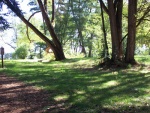 0306-Area just east o
0306-Area just east o
f the post in 0... -
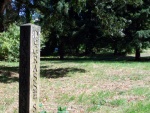 0309-Same post, looki
0309-Same post, looki
ng towards the ... -
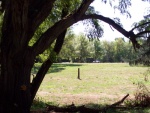 0310-Longtain & M
0310-Longtain & M
ontcalm St. pos... -
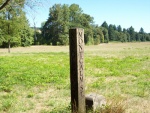 0313-Looking towards
0313-Looking towards
the river (mark...
-
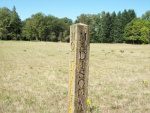 0319-Same post lookin
0319-Same post lookin
g NW, towards u... -
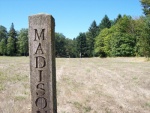 0322-Looking down Deg
0322-Looking down Deg
rasse St (West)... -
 Birth of Oregon [Nais
Birth of Oregon [Nais
sance de l'Orég... -
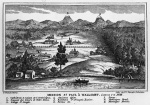 Mission St. Paul, Wal
Mission St. Paul, Wal
lamet

